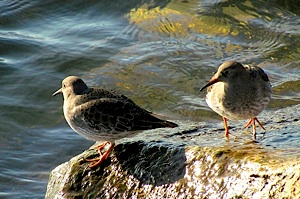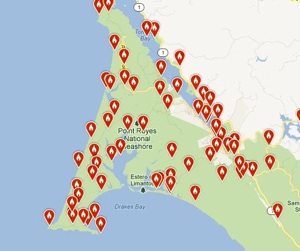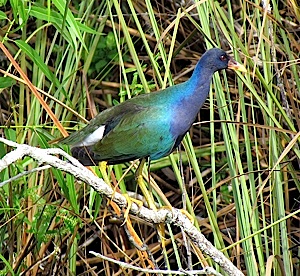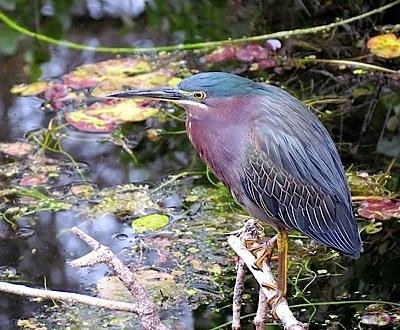Spring migration is winding down across much of North America, and it’s time for birders to relax and reflect. I’ve been contemplating happy thoughts such as where I would go if given an all-expenses paid birding trip to any U.S. national park in the next 12 months. No one has offered this to me yet, but I made up a list in my head.
I’m presuming this mystery benefactor doesn’t have access to planes that go off the continent, otherwise places like Hawaii Volcanoes National Park, National Park of American Samoa, and Virgin Islands National Park would top the list.
Being a slave to convention and having a migration-addled brain, I’ve resorted to the admittedly cliché “top ten” list.
Sure, it may have barely made this list, but out of about 400 contenders, 10th isn’t too shabby. The 14th annual Acadian Birding Festival just wrapped up last weekend with throngs of happy birders adding plenty of ticks to their life lists. (A “tick” is a birding term for an addition to a bird list of any kind. It doesn’t refer to actual ticks, which are something birders should take precautions to avoid.) Acadia benefits from being very close to the highly productive waters of the cold North Atlantic. Cold water holds lots of oxygen, which allows lots of plankton to flourish, which feeds lots of fish, and seabirds love fish. Sure, you can get some fascinating seabirds by taking a pelagic cruise far off the coast of Cape Hatteras, but you have to really get out there. In breeding season, it’s a comparatively short jaunt from Acadia to see Atlantic Puffins.

Purple sandpipers at Acadia National Park. Kirby Adams photo
Toss in some boreal species that appreciate the high latitude, and Acadia’s a lifer factory for a lot of birders.
9. Big Cypress National Preserve
The first of three Florida parks you’ll see on this list, Big Cypress made the cut because it has one of the birdiest highway drives in the world. U.S. Route 41, the famous Tamiami Trail connects Naples to Greater Miami by cutting through the heart of Big Cypress. For much of the trip a canal parallels the highway, which may not be the most natural setting, but the bird life is stunning. I dare anyone to find more Great Egrets, Snowy Egrets, Belted Kingfishers, and Anhinga from their car at 60 m.p.h. anywhere else in America. Of course, you’ll want to pull over to a roadside park every once in a while and maybe catch a glimpse of the rare Snail Kite patrolling the ponds for Apple Snails.
8. Apostle Islands National Lakeshore
This was a tough choice. Another Lake Superior park, Pictured Rocks National Lakeshore, has very similar avifauna, and both parks claim the title of nesting warbler champion with 23 species each. It’s a lot of fun to watch warblers during migration, but a more challenging, and in my opinion, more rewarding endeavor to visit them on their summer territory. Watching the Bay-breasted warblers forage for Spruce Budworms gives an ecological perspective to migratory birds. Apostle Islands got the nod over Pictured Rocks for having nesting endangered Piping Plovers on park property, but you really can’t go wrong birding either park on Superior’s south shore.
7. Perry’s Victory and International Peace Memorial
Yes, you heard that right. And, no, this hasn’t turned into a list of the best battlefield memorials. We’re still talking about birds. Lots of migrating birds, in fact. The memorial sits on South Bass Island, conveniently located in Lake Erie roughly between the Crane Creek area of Ohio and Point Pelee National Park in Canada. Those latter two names are legendary in birding for the conglomeration of migrating songbirds that gather before and after a crossing of the lake. Plenty of them take a respite on the Lake Erie islands as well. Luckily someone built a 350-foot tower for bird observation on South Bass Island. (Commemorating Perry’s victory in the War of 1812 and the lasting peace with the British Empire were the primary reason, I hear.) It’s important to note the memorial is closed for renovation, so it’s all ground scouting for warblers for the time being.
Olympic goes beyond the call of duty for habitat diversity. Temperate rainforest, treeless mountaintops, and sea coast are all available in one park and, with some planning, can all be visited in one glorious day of birding. I don’t know of anywhere else to see a Sooty Grouse on a barren mountain, a Red-naped Sapsucker picking through epiphytic ferns, and a Heerman’s Gull fishing the sea shore all in one afternoon. The endangered Marbled Murrelet, a relative of the puffins, also makes a home in Olympic, where a really lucky birder might catch a glimpse of them nesting in the old growth forest.
5. Padre Island National Seashore
Birds flock to Padre Island for spring migration just like crazed college students flock to South Padre Island for Spring Break. Sitting right on the central migration flyway, Padre Island boasts a variety of habitats that make it an ideal stopping point for songbirds and shorebirds alike. Thirteen threatened or endangered birds make a home or pass through the seashore. If you can’t make it to Florida (see #1 on this list), this is the place to go to spot a Roseate Spoonbill, often considered a denizen of only the Sunshine State.
With only seven nesting species, this park is probably more deficient in nesting bird diversity than almost any other unit in the system. But the birds that do nest there, such as the Sooty Tern, do so in spectacular fashion. Roger Tory Peterson of field guide fame called the Sooty Tern colony on Bush Key “the number one ornithological spectacle on the continent.” Who am I to argue with Mr. Peterson? (Even if I did rank it #4.) Throw in some Brown Noddies nesting with the sooties and some Red-footed Boobies passing through and you have a destination that is a can’t-miss for North American birders.

This map taken from eBird.org shows the birding hot spots at Point Reyes National Seashore.
3. Point Reyes National Seashore
With the current total at 490 species, Point Reyes claims more birds than any other national park unit. It sits along the Pacific flyway, boasts a variety of habitats, and being a peninsula, acts as a “trap” for migrants. A well-timed trip to the point for an eastern birder could double a life list. Two threatened species from quite diverse habitats, the Northern Spotted Owl and the Snowy Plover, are the subject of ongoing studies at Point Reyes. Access couldn’t be much easier either, with this bird Nirvana being a short drive from San Francisco.
Big Bend manages to claim the title for most birds in a national park with the word “park” in its title. More than 450 species have been recorded in the park. Many are migrants that pass through, though some are tropical species that occasionally overshoot their nesting grounds and end up north of the Rio Grande. The unofficial bird of Big Bend, the Colima warbler is a highly sought-after bird with birders filling out a North America list that includes sightings only in the United States (sans Hawaii), Canada, and Greenland. The Colima mostly nests in the mountains of northern Mexico, but a few pair make it up to the Chisos Mountains in Big Bend every spring. Arizona has some excellent desert birding, but the diversity in Big Bend keeps the birders coming back for more.
You can’t mess with the champ. When people think of the Everglades, birds generally come to mind. (Alligators as well, but those are just wingless, featherless birds (almost) according to current taxonomy.) Birds are one of the reasons the Everglades area was set aside to be protected.

The Purple gallinule is one of the more colorful denizens of Everglades National Park. Kirby Adams photo.
The Anhinga Trail is among the most famous bird walks in the world, a spot where normally reclusive birds like American Bittern strut right out and show themselves. Short-tailed Hawks, Snail Kites, Flamingoes, Roseate Spoonbills, Gray Kingbirds…
The list of Florida specialties that can be found in the Everglades is like a who’s who of birds from the want-lists of every birder.
Everglades remains the champ because it makes birders out of anyone lucky enough to visit. Big Bend has some rare birds, but many are hard to find and not very charismatic. The birds of the Everglades are in-your-face, hot pink, and ready to be seen. If you’re a birder, you go there. If you aren’t a birder, you will be. End of story.
So, there’s my list. Now, who was writing that blank check for my next national park birding adventure?


 Support Essential Coverage of Essential Places
Support Essential Coverage of Essential Places







Comments
Don't forget Canaveral NS and neighboring Merritt Island National Wildlife Refuge. Black Point Wildlife Drive is a great place to watch all the wildlife and catch the sunrise/sunset.
Canaveral NS is certainly a good one. Merrit Island is one of the best birding spots in North America, but it's administered by FWS rather than NPS, so Kurt won't let me talk about it here! ;-)